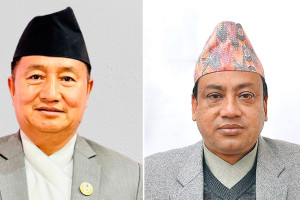Opinion
Education, Nepali-style
Here is why students will do well in their School Leaving Certificate exams this year
Kathryn S. March
Why will they succeed in their exams again this year? Because someone they’ve never met is going to grade them on questions that another group of people they’ve also never met wrote, based upon a syllabus that yet more unmet people designed, which they were taught by a revolving team of people who may or may not themselves have studied the material they are required to teach. This broken pedagogical chain is perversely but perfectly constructed to promote student success in those exams.
Fractured factoids
How does this happen? Under the widespread educational regime in Nepal, where there is no continuity nor any academic or intellectual autonomy, it becomes possible only to teach disjointed facts—factoids, if you will. A factoid is something that is basically true, that is, it is a fact that most people recognise, but requires no interpretation, context, or real understanding. ‘The sky is blue’; ‘colour is light in the visible spectrum’; ‘light is a form of energy’; and ‘e=mc²’ are, from this perspective, all factoids. Factoids have the especially useful
capacity to be learned and recombined in almost any order and still give the
appearance of organised knowledge.
Expert mastery of factoids is essential to success in national exams in Nepal.
The fractured system of teaching factoids that is found in many places across Nepal produces and is produced by what is known as ‘The Routine’. The Routine is a method of scheduling classes with multiple and/or part-time instructors dividing their teaching of subjects so that a chart can be given to students showing, for example, that: Sir Ka teaches ‘e=mc²’ on Monday; Sir Kha teaches ‘colour is light in the visible spectrum’ on Tuesday; Madam or Miss Ga teaches ‘the sky is blue’ on Wednesday; class is cancelled on Thursday; and Sir Gha will be teaching ‘light is a form of energy’ on Friday.
Such a syllabus on the physics of light might be intellectually integrated in the abstract, but from the perspective of the students sitting obediently at their benches, it is a jigsaw puzzle. For most students—and quite possibly for many teachers as well—reassembling the big picture from all these factoid pieces is a daunting and often impossible task. The best that they can do is to commit to memory the details of each and every piece of the factoid jigsaw puzzle, without ever being able to grasp the full significance of the theories that organise them.
Fortunately, for all the students currently sitting for the School Leaving Certificate (SLC) exams in Nepal, a prolific catalogue of rote factoids is exactly what is required to succeed in the kind of exams that are equally the result of this fractured system of education. An exam answer to a question about light and energy which includes all four of my hypothetical factoids will almost certainly exhibit sufficient recombinant apparent knowledge to shine in the tabulation of results.
Teaching for Nepal
One relatively new effort in Nepal offers education in a new light. Teach for Nepal (TFN) aims to redress the inefficiencies and inequities in education by recruiting, training, and supporting highly motivated young college graduates to volunteer to teach in high-need public schools for two years. Teach for Nepal was founded by social grassroots activist Shisir Khanal and is one of 35 national organisations that are now part of the global Teach for All network established by Wendy Kopp (of Teach for America) and Bret Wigdortz (of Teach First). Teach for Nepal placed its first batch of volunteer teachers in 2013 and their third batch is currently being trained. Their mission is “to develop a movement of leaders who will eradicate education inequality in Nepal. One day, all children in Nepal will receive an excellent education.”
On the surface, Teach for Nepal’s goal is to make sure that more students pass the SLC and, especially, to make sure that students who attend public schools have the same chances afforded to those in the thriving private school and tuition industry. Clearly, this is an important goal, integral to any hopes for social justice in Nepal, since education is the only pathway to success open to those without other resources. Ultimately, however, Teach for Nepal is about transforming not only access to, but the very nature of, education in Nepal. “A teacher’s purpose,” according to the Teach for Nepal website, “is not to create students in his own image, but to develop students who can create their own image.”
In the meantime, cram on, all you students who are not getting married this season. Yours will be a First Division, if not Distinction. Yours, however, will not be comprehension, curiosity, or the capacity to generate meaningful new knowledge.
March is Professor of Anthropology, Feminist/Gender/Sexuality Studies, and Public Affairs at Cornell University, the US




 24.71°C Kathmandu
24.71°C Kathmandu






.jpg&w=200&height=120)





